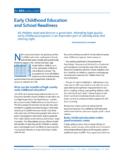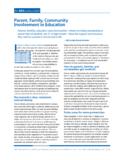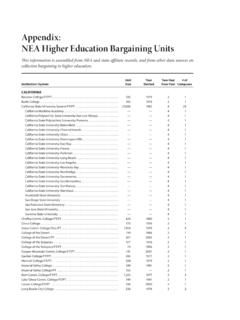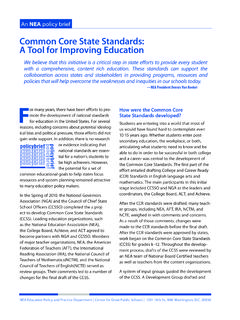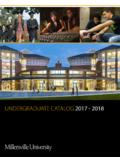Transcription of Recruiting and Retaining Quality Teachers for High …
1 1 Insights from NBCT Summits and Other Policy InitiativesRecruiting and RetainingQuality Teachers forHigh-Needs Schools:Insights from NBCT Summitsand Other Policy InitiativesBarnett Berrywith Melissa Rasberry and Alice WilliamsCenter for Teaching Quality1 Center for Teaching Quality / from NBCT Summits and Other Policy InitiativesMuch like in other fields ( , business, health care,or the military), a range of incentives are sometimesused to compensate people for tackling challengingteaching assignments and jobs. Some policymakersrecognize that incentives are needed to compensateteachers more when they agree to work in high-needsschools, but many states still lack such to the latest survey by Education Week, only17 states offer incentives of any kind for Teachers toteach in high-needs Indeed, policymakersshould be concerned about where the mostaccomplished Teachers like National Board CertifiedTeachers (NBCTs) are teaching.
2 The vast majorityof NBCT incentives, while important in encouragingand recognizing accomplished Teachers are generallydivorced from efforts to make the distribution of top-flight Teachers more With several researchstudies showing that few NBCTs teach in high-needsschools,5 it is unfortunate but not surprising thatGeorgia policymakers recently passed a policyeliminating across-the-board salary incentives for theseaccomplished Teachers and only rewarding them a 10percent salary increase if they work in a school thathas been on the state s roster of low-performing schoolsfor two or more consecutive teacher Incentive LandscapeAs teacher shortages have escalated, school districts haveexplored varying types of incentive programs.
3 Forexample, over the last several years, Charlotte-Mecklenburg ( ) and the State of Arkansas havedesigned programs with multiple financial elementsto attract Teachers to high-needs schools and , the Massachusetts Signing BonusProgram and the New York Teaching Fellows Programwere created to entice non-traditional recruits intochallenging schools. Efforts like these have produced,in retail parlance, a great deal of curb appeal forcertain high-needs districts, but for incentive programsto be truly successful, they must be based on themultiple factors that influence Teachers decisions aboutwhere to practice their issues are not simple and often myths get in theway of the facts. One pervasive myth that hobblesmany recruitment and retention efforts is that financialincentives are the silver bullet solution for high-needsschools.
4 Bess Keller s fascinating Education Week storyof five Cleveland Teachers revealed the significance ofother factors in Teachers decision-making. The articleThe facts are daunting: Poor children and those of color are far less likely to be taught byqualified Teachers no matter how the term qualified teacher is defined. Studiesconsistently show that Teachers who are better trained, more experienced, and licensed inthe subjects they teach are more likely to be teaching in more affluent schools, servingmore academically advantaged The same is true for Teachers who generate higherstudent test scores as well as those who earn National Board Addressing themaldistribution of qualified Teachers may be the most vexing public school problem facingAmerica s policymakers for Teaching Quality / and Retaining Quality Teachers for High-Needs Schoolshighlighted how special preparation for urbanteaching, support from more experienced colleagues.
5 And schools that offered opportunities for knowingstudents better ( , through more flexible schedulesand advisory classes) all played an important role inrecruiting and Retaining them. New teacher retentionimproves when history majors like mid-career switcherAllison Hauserman are not expected to teach specialeducation, as she was initially assigned to the most part, few teacher recruitment andretention policies and programs have been formallystudied or In writing this paper, staff ofthe Center for Teaching Quality (CTQ) investigated anumber of current efforts and found that mostincentive programs including federal and state teacherscholarships and salary differentials for high-needssubject area Teachers contained no managementinformation systems that could provide policymakerswith the data they need on program example is Mission Possible in Guilford County( ).
6 Through this program, the district pays algebrateachers up to $14,000 more if they teach in high-needs schools and their students show solid progresson state exams. Unfortunately, it is unknown whetherdata are collected on how this investment impacts thenumbers of teaching applicants. In fact, theadministrator we contacted was not sure if the district tracked the numbers from year to year. Thisexperience is not unique and underscores the need formore solid Department of Education recently launchedits $99 million teacher Incentive Fund designed torecruit and retain Teachers for high-needs schools andto pay them more for higher student federal program has funded 34 states and schooldistrict programs thus far, including Denver where theteachers union and school administrators have co-created a comprehensive incentive package that focuseson redesigning the teacher development Programs for Teachersin High-Needs Schools or SubjectsIn Charlotte-Mecklenburg ( )
7 , the schooldistrict offers a variety of incentives to attractand retain Quality Teachers to their FOCUS(Finding Opportunities, Creating UnparalleledSuccess) schools. For example, any educatorcan receive up to $3,000 in signing bonuses forworking in these high-needs schools, whilemaster Teachers with a demonstrated record ofsuccess can earn an additional $2,500 inretention bonuses. Another $1,400 can be earnedbased on high academic change or achievementlevels by students on several state State teacher Assistance Resource (STAR)Program of Arkansas provides two years offorgivable loans in a four-year program forteacher education students willing to teachmath, science, special education, or foreignlanguages.
8 The normal $3,000 loan forgivenessfor each year is doubled to $6,000, if the studentis willing to teach one of these high-needssubjects in an area of the state that has a criticalshortage of Teachers . A total of 465 studentswere funded in 2006-07, up from 264 studentsin for Teaching Quality / from NBCT Summits and Other Policy InitiativesNew SolutionsOver the last 24 months with support from theNational Education Association and the NationalBoard for Professional Teaching Standards over2,000 National Board Certified Teachers (NBCTs)from North Carolina, Ohio, Oklahoma, SouthCarolina, and Washington examined teacherrecruitment and retention research and participated instructured dialogues with leading policymakers fromtheir states.
9 Summits were organized for NBCTs inMississippi and Wisconsin as well (this paper wascompleted prior to the Mississippi summit and beforethe release of the Wisconsin summit report). Afterstudying the research, teacher leaders from the fivestates developed a comprehensive set of policyrecommendations based on both evidence and theirunique experiences many in high-needs schools. Thecollective voices of these NBCTs have made adifference in several of the states, but much more needsto be done. In this paper we draw on the best availableempirical evidence, key case studies, and the insightsfrom some of the nation s most accomplished teachersto suggest how we may build on the foundation ofexisting programs.
10 Let s start with the research Evidence on Financial IncentivesPolicymakers assume that financial incentives are criticalto Recruiting and Retaining Teachers for high-needsschools. Based on the research, they are right but onlypartially right. For example, several recent investigationsconclude that higher teacher salaries improve the qualityof Teachers who enter a school district8 and serve asimportant incentives in keeping them Severallabor economists have shown that financial incentivescan make high-needs schools more attractive to morequalified Teachers . No one should be surprised, yet theseBeginning in the summer of 2005, the NationalEducation Association in collaboration with theNational Board for Professional TeachingStandards initiated a series of state policysummits on how to recruit and retain teachersfor high-needs schools.

